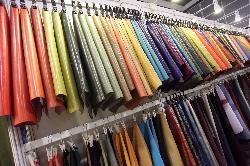The leather industries in Brazil and Argentina have been knocked sideways by the fall in demand for all types of leather. Both countries export mainly to China, their largest customer by far. Latest statistics indicate that Brazil’s leather exports declined by a whopping 60% in January 2009 compared to the same month in 2008 and, in the same period, Argentina’ exports fell by 50%.
Despite the fact that the financial crisis has not hit the local banks in South America as it has in the US and Europe, the knock-on effects have traveled down the leather production chain as demand for all types of leather fell sharply.

The major tanneries in Argentina and Uruguay had dedicated themselves to supplying the automotive industry with leather seats from some of the most modern and efficient finishing plants in the world. Four major tanneries have suspended production at these plants, laid off workers, as the demand for new vehicles has declined at an alarming rate since mid 2008. Containers are held up in ports and orders have been put back several months or canceled altogether.
The Argentine government has launched a plan to try and save parts of the tannery, footwear and leather goods industry but this may only manage to prop up companies until there are signs that consumer demand and purchases from tourists recover.
The fall in consumer confidence in the US and Europe has had a “contagion” effect in Latin America, with retail sales suffering in all countries. Argentinean manufacturers speak of the negative psychological impact pervading the economy which has paralyzed spending and investment decisions.
Even in Venezuela, where local currency has to be spent in the domestic market place, due to a six year old exchange control regime which makes it almost impossible to buy hard currency, demand at the many shopping malls has fallen.
With consumers buying less luxury goods and impulse buying restricted, families are tending to purchase essentials. This has kept meat demand at a steady level and so the number of animals slaughtered has hardly declined. As a result the number of hides being salted and stored at slaughter houses has ballooned waiting for buyers. Hide prices are now lower at any time this century but with few buyers, tanneries well stocked and storage space at a premium, reports have surfaced indicating that raw hides have been buried in Brazil and Argentina.
In the last six months the US dollar has strengthened significantly against all local currencies in Latin America, which in theory at least, should make shoe exports cheaper and imports more expensive. However, an influx of “technically contraband” footwear from Asia (mainly China) costing as little as US$1 per pair has invaded local markets. The Brazilian Footwear Association (Abicalçados) has launched an investigation into the 40 million pairs of Chinese shoes which arrived in 2007. Argentina is asking Brazil for its advice on how to handle such imports, as this country is also suffering the same fate.
In the north of the continent footwear is arriving in the Andean countries after being triangulated from China via Panama’s Free Port. Ecuador has just announced a new import tax of US$10 on each pair of shoes imported. Colombian manufacturers are also struggling against a tide of cheap Chinese imports which has been threatening the industry for at least five years and no real tangible results have been achieved to stop under billing of imports.
Brazil and Mexico are still subsidising companies to exhibit at international fairs in an attempt to maintain a decent level of exports by promoting marketing and sales. This would seem to be the logical strategy to adopt but not all countries think the same. Both Argentina’s and Colombia’s export agencies have suffered substantial budget cuts and this has left local manufacturers fighting a rearguard action in an effort to regain market share domestically.
Initiatives and incentives to companies are vital at this point in time, as well as subsidies to send companies abroad in an effort to maintain levels of exports. However, until there is a recovery in consumer demand in Europe and the US, Chinese production will be limited with less semi finished and finished leather being required from the main Latin American producers. The best thought-out support plans for ailing companies will only reap their benefits if consumers start buying again tempted by special offers and promotions.
In the meantime, China will turn its energy to its huge internal market if demand in traditional export countries does not show signs of recovering. The tide of Chinese exports, both legal and illegal, to Latin American consumers at accessible prices will continue. This means that countries and their national associations will be on the defensive to recover market share in their own countries.





